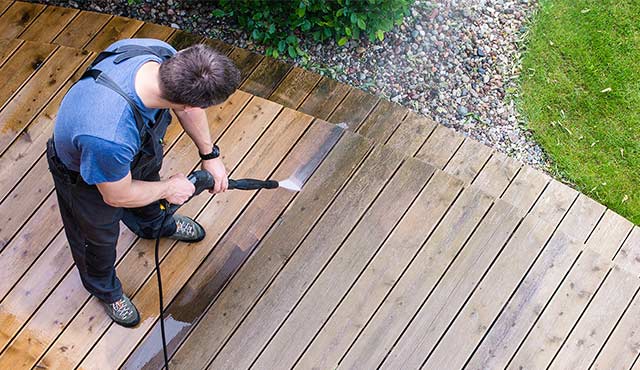Choosing the Right Discoloration for Your Fence: Tips and Considerations
When it comes to enhancing the appearance and preserving of your fence, selecting the right discolor is vital. We will certainly discover the various types of fence spots, aspects to think about prior to choosing a discolor, tips for preparing your fence for staining, and the distinctions in between water-based and oil-based spots. Additionally, we will dive into picking the best discolor shade to enhance your fence and enhance your exterior space.
Recognizing Various Kinds Of Fencing Spots

On the various other hand, water-based stains are made from acrylic or latex and supply an extra refined color to the wood. Water-based spots are simpler to cleanse up and have a quicker drying time contrasted to oil-based discolorations.
Picking between water-based and oil-based discolorations relies on different aspects, including individual preference, the desired appearance, and the level of upkeep called for. Oil-based stains are suggested for surround high-traffic areas or those continuously revealed to severe climate problems. fence staining. Water-based spots, on the other hand, are a prominent choice for fence suburbs where appearance and ease of usage are necessary
Comprehending the differences in between oil-based and water-based stains helps homeowners make an informed decision when selecting the ideal tarnish for their fencing. Thinking about the specific demands of the fencing, such as its area, exposure to sunshine, and desired aesthetic, will make sure that the selected tarnish provides long-lasting defense and boosts the total charm of the fence.
Elements to Consider Prior To Selecting a Spot

Different kinds of timber absorb spots in a different way, resulting in varying degrees of color intensity and toughness. Furthermore, particular woods might be a lot more prone to concerns like rot or insect invasion, which may influence the choice of stain to shield and maintain the fencing.
The environment and weather conditions in your location ought to likewise be considered. You may require a tarnish that gives added security versus dampness and UV rays if you live in an area with harsh winter seasons or high moisture. If your fencing is revealed to guide sunlight for lengthy durations, a discolor with UV preventions can help avoid fading and staining.
Lastly, it's crucial to consider your wanted visual. Various spots offer different shades and surfaces, permitting you to customize the look of your fencing (fence staining and sealing). Think about the overall design and style of your building, as well as any kind of local regulations or home owner association standards that may determine the appropriate stain shades
Tips for Readying Your Fence for Staining
Cleansing the fence is a crucial action as it gets rid of dirt, gunk, and any previous layers that might interfere with the discoloration process. Rub the surface area gently, paying added focus to locations with persistent stains or mold and mildew.
This action is essential as tarnishing a wet or wet surface can lead to poor adhesion and an irregular finish. Make sure that the fencing is completely dry prior to continuing with the staining process.
Before discoloration, examine the fence for any kind of damages, such as loosened boards or nails. This item aids to open up the timber pores, permitting the tarnish to penetrate more effectively and equally.

Contrasting Water-Based and oil-based Stains
When picking a tarnish for your fence, it is necessary to contrast the attributes and advantages of water-based and oil-based spots. Both types of stains have their very own benefits and considerations, so it is vital to comprehend the distinctions in between them.
Oil-based discolorations are recognized for their durability and resistance to put on and tear. In addition, oil-based stains tend to last longer than water-based stains, making them a popular choice for fencings.
On the various Check Out Your URL other hand, water-based discolorations are a lot more eco-friendly and less complicated to tidy up. They have a lower VOC (unstable organic compound) content, which suggests they launch less damaging fumes into the air. Water-based stains also completely dry quicker, permitting a quicker application and less downtime. Nonetheless, they might not provide the very same level of protection as oil-based discolorations, particularly in severe climate condition.
Ultimately, the selection between oil-based and water-based discolorations depends upon your specific requirements and preferences. When making your decision, think about factors such as longevity, environmental influence, and convenience of application. Consulting with an expert or looking for recommendations from specialists can also assist make certain that you choose the appropriate stain for your fence.
Picking the Right Stain Shade for Your Fencing
The option of a proper stain color for your fencing is an essential aspect of improving its visual appeal and matching the total layout of your outdoor area (fence staining and sealing). The right tarnish color can change a plain, average fence right into a striking focal point that includes depth and personality to your home
When choosing a discolor color for your fencing, it is essential to consider the design and architecture of your home. If you have a traditional or typical style home, natural tones such as browns and neutrals can produce a cozy and inviting appearance. On the other hand, if you have a modern or modern home, you might take into consideration choosing vibrant and dynamic colors that make a statement.
An additional aspect to take into consideration is the natural surroundings of your home. If you have a whole lot of greenery, a tarnish color that matches the all-natural landscape, such as environment-friendlies or crimsons, can produce a harmonious and natural appearance.
Additionally, it deserves taking into consideration the upkeep needed for various stain colors. Lighter colors have a tendency to show dirt and wear more conveniently, while darker colors can conceal flaws and call for less frequent touch-ups.
Eventually, the choice of tarnish color for your fence need to reflect your personal style and choices - fence staining companies. Make the effort to explore various alternatives and get in touch with with experts if needed, to ensure that you choose the ideal stain shade that boosts the charm and charm of your fencing
Conclusion
In verdict, when it comes to choosing the appropriate discolor for your fencing, it is very important to comprehend the various kinds of stains offered and take into consideration aspects such as longevity and desired look. Preparing the fencing properly before discoloration is essential for attaining ideal outcomes. In addition, comparing oil-based and water-based stains can help establish the most effective alternative for your particular requirements. Last but not least, choosing the appropriate tarnish shade can improve the overall appearances of your fence.
We will discover the various types of fence stains, factors to take into consideration before choosing a discolor, pointers for preparing your fence for staining, and the differences in between water-based and oil-based spots.Differentiating in between oil-based and water-based stains is vital when comprehending various kinds of fence spots. Water-based spots are less complicated to clean up and have a much faster drying time compared to oil-based stains. Furthermore, oil-based stains often tend to last longer than water-based discolorations, making them a preferred selection for fences.
In verdict, when it comes to picking the appropriate discolor for your fencing, it is vital to comprehend the various kinds of stains readily available and take into consideration elements such as toughness and wanted appearance.